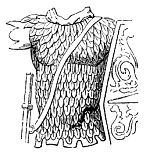
The lorica plumata (Latin pronunciation: [loːr̺iːka pluːmaːt̪a], "feathered cuirass")[2][3] also known the lorica hamata squamatque[4] ("hooked and scaled cuirass") was a set of Roman body armor. Unlike the more common lorica squamata, the scales of this cuirass bore a ridge down the middle, like the shaft of a feather, from which the name derives.[5]
The lorica plumata was sleeveless and worn without shoulder-guards, resembling a linothorax.[6] Due to its rarity and higher production and maintenance costs, it may have been reserved for higher-ranking soldiers, tribune or above.[5][7] The lorica plumata would have been an expensive piece of military equipment.[3] Unlike most contemporary Roman armor, it combined mail and scales.[3]
- ^ Cavenel, Charles (1984). "Lorica". mediterranees.net (in French). Archived from the original on October 23, 2022. Retrieved 2023-05-01.
- ^ Lapatin, Kenneth (2015-07-01). Luxus: The Sumptuous Arts of Greece and Rome. Getty Publications. ISBN 978-1-60606-422-1.
- ^ a b c Wijnhoven, Martin (2009). "Lorica Hamata Squamatque: A Study of Roman Hybrid Feather Armor". The Journal of the Mail Research Society. 2: 3 – via academia.edu.
- ^ Dawson, Timothy (2013-08-05). Armour Never Wearies: Scale and Lamellar Armour in the West, from the Bronze Age to the 19th Century. The History Press. ISBN 978-0-7524-9424-1.
- ^ a b Ermatinger, James W. (2015-08-11). The World of Ancient Rome: A Daily Life Encyclopedia [2 volumes]: A Daily Life Encyclopedia. ABC-CLIO. ISBN 978-1-4408-2908-6.
- ^ D'Amato, Raffaele; Sumner, Graham (2009-09-17). Arms and Armour of the Imperial Roman Soldier: From Marius to Commodus, 112 BC–AD 192. Frontline Books. ISBN 978-1-4738-1189-8.
- ^ Marcia, Sandra (2007). The natural armor of fish: an exploration of a biological composite. University of Washington.